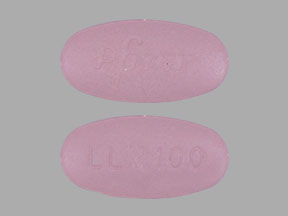Lorlatinib and Alcohol/Food Interactions
There are 3 alcohol/food/lifestyle interactions with lorlatinib.
Lorlatinib Food/Lifestyle
Major Food Interaction
GENERALLY AVOID: Grapefruit and grapefruit juice may significantly increase the plasma concentrations of lorlatinib. The proposed mechanism is inhibition of CYP450 3A4-mediated first-pass metabolism in the gut wall induced by certain compounds present in grapefruit. Because grapefruit juice inhibits primarily intestinal rather than hepatic CYP450 3A4, the magnitude of interaction is greatest for those drugs that undergo significant presystemic metabolism by CYP450 3A4 (i.e., drugs with low oral bioavailability). In general, the effect of grapefruit juice is concentration-, dose- and preparation-dependent, and can vary widely among brands. Certain preparations of grapefruit juice (e.g., high dose, double strength) have sometimes demonstrated potent inhibition of CYP450 3A4, while other preparations (e.g., low dose, single strength) have typically demonstrated moderate inhibition. Pharmacokinetic interactions involving grapefruit juice are also subject to a high degree of interpatient variability, thus the extent to which a given patient may be affected is difficult to predict.
MANAGEMENT: Patients treated with lorlatinib should avoid consumption of grapefruit, grapefruit juice, and any supplement containing grapefruit extract. If coadministration is unavoidable, some authorities recommend reducing the initial dosage of lorlatinib from 100 mg orally once daily to 75 mg orally once daily. In patients who have had a dosage reduction to 75 mg orally once daily due to adverse reactions, the lorlatinib dosage should be further reduced to 50 mg orally once daily upon initiation of a potent CYP450 3A4 inhibitor. After 3 plasma half-lives following discontinuation of the potent CYP450 3A4 inhibitor, the lorlatinib dosage may be increased to that used prior to initiation of the inhibitor.
References (2)
- Cerner Multum, Inc. "UK Summary of Product Characteristics."
- (2018) "Product Information. Lorbrena (lorlatinib)." Pfizer U.S. Pharmaceuticals Group
Switch to consumer interaction data
Lorlatinib High Cholesterol (Hyperlipoproteinemia, Hypertriglyceridemia, Sitosterolemia)
Moderate Potential Hazard, Moderate plausibility
lorlatinib - hyperlipidemia
Increases in serum cholesterol and triglycerides have been reported in patients receiving lorlatinib. Grade 3 or 4 elevations in total cholesterol occurred in 17% and Grade 3 or 4 elevations in triglycerides occurred in 17% of the patients enrolled in a clinical trial with up to 80% percent of patients requiring initiation of lipid-lowering medications. Caution is advised in patients with hyperlipidemias. Monitor serum cholesterol and triglycerides before initiating treatment and 1 and 2 months after initiating, and periodically thereafter. Initiation or increase of the dose of lipid-lowering agents might be required on these patients.
References (1)
- (2018) "Product Information. Lorbrena (lorlatinib)." Pfizer U.S. Pharmaceuticals Group
Lorlatinib High Blood Pressure (Hypertension)
Moderate Potential Hazard, Moderate plausibility
lorlatinib - hypertension
The use of lorlatinib might cause hypertension. It is recommended to assess and control blood pressure prior to treatment initiation. Caution should be exercised when treating patients with prior history of hypertension, uncontrolled hypertension, and those at risk. Monitor blood pressure after 2 weeks and at least monthly thereafter during treatment. Withhold and resume lorlatinib at a reduced dose or permanently discontinue treatment based on severity.
References (1)
- (2018) "Product Information. Lorbrena (lorlatinib)." Pfizer U.S. Pharmaceuticals Group
Switch to consumer interaction data
Lorlatinib drug interactions
There are 546 drug interactions with lorlatinib.
Lorlatinib disease interactions
There are 8 disease interactions with lorlatinib which include:
- atrioventricular block
- CNS effects
- hepatotoxicity/hepatic impairment
- hyperglycemia
- hyperlipidemia
- hypertension
- interstitial lung disease
- severe renal impairment
More about lorlatinib
- lorlatinib consumer information
- Check interactions
- Compare alternatives
- Side effects
- Dosage information
- During pregnancy
- Drug class: multikinase inhibitors
- Breastfeeding
- En español
Related treatment guides
Drug Interaction Classification
| Highly clinically significant. Avoid combinations; the risk of the interaction outweighs the benefit. | |
| Moderately clinically significant. Usually avoid combinations; use it only under special circumstances. | |
| Minimally clinically significant. Minimize risk; assess risk and consider an alternative drug, take steps to circumvent the interaction risk and/or institute a monitoring plan. | |
| No interaction information available. |
See also:
Further information
Always consult your healthcare provider to ensure the information displayed on this page applies to your personal circumstances.


